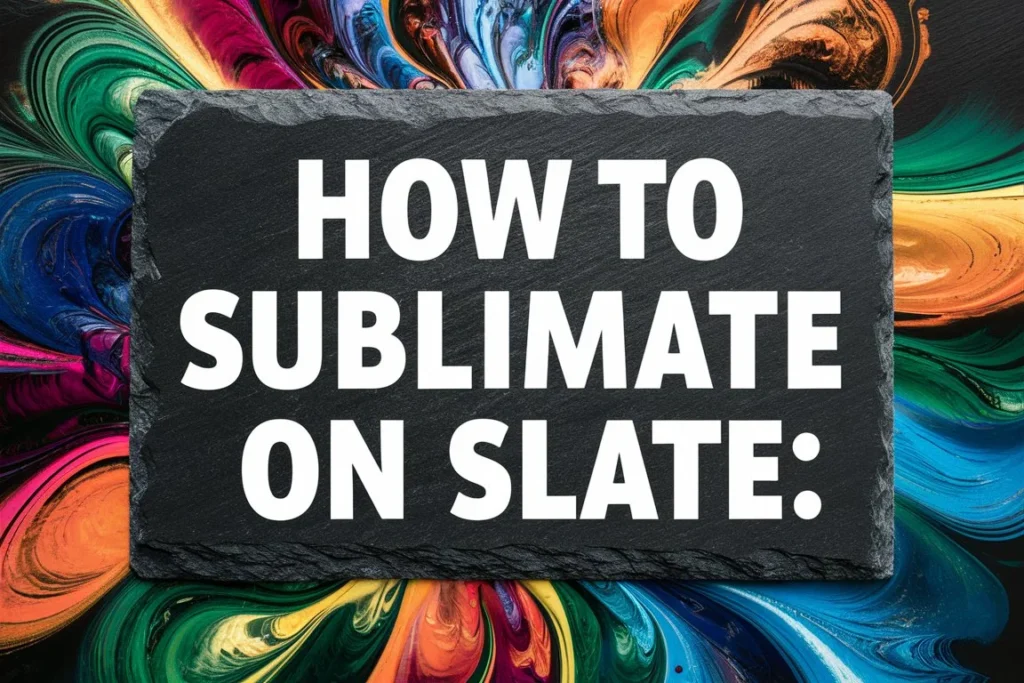Sublimate on Slate
Sublimate on Slate Sublimation is a printing process that is used to print designs on different items like shirts, hats, slates and more. Meanwhile slate is a rock type that is formed in a shape with plane sides.
Today we are going to talk about the process of sublimation on slate. With this technique you can create some really good looking and astonishing decorative items, so let’s get started:
Table of Contents
Supplies For Sublimation On Slate
Sublimation Printer, Ink and Paper: You will be needing a sublimation printer for printing, a sublimation ink that is compatible with your printer (read the manufacturer’s instructions) and a sublimation paper. This special paper absorbs your design and transfers it to the slate under heat and pressure.
Heat Press: A heat press is required to press the design on the slate.
Heat-Resistant Tape: It fastens the designs securely so it will be easy to press it.
Lint Roller: It is used to clean the surface of slate for the pressing process.
Blank Slate: Remember to get a slate according to your design’s shape and size.
Protective Paper (Optional): Provides an extra layer of protection for your heat press.
Heat Conductive Mat (Optional): When sublimating delicate substrates (such as tiles, ornaments, ceramic plates, glass, or acrylic), heat conductive mat helps distribute heat evenly and ensures effective sublimating.
Now let’s have a look at the process of Sublimation on slate
Process
Prepare the Slate: Use a lint roller to clean the surface of the slate on which you are going to print your design. Lint roller will remove any dust or debris that might interfere with the transfer.
Get your Design: Create a design on your computer or get a premade design, remember to have a format that your printer supports. If you are going to print a photo, try to get a high quality image so it will look nicer. Always flip your design or photo because it will be mirrored during the process.
Print it: Insert your sublimation paper into your printer according to instructions given with your machine manufacturer. Remember to use the printable side of the paper for printing, usually the shining white side is the printable side of the paper. Using sublimation ink, print heat transfer paper with your design/photo.
Position it: There are two main approaches for placing your design on the slate. For Full Coverage make sure your image is larger than the slate itself, with the design extending to the edges. This ensures complete coverage without any white borders. If you prefer a White Border Design, create an image smaller than the slate and center it precisely on the sublimation paper before placing the slate on top.
Secure it: Carefully place the sublimation paper face down on your working surface. Place the blank slate face down on top of the image, make sure your design is aligned correctly. Use heat-resistant tape to firm it. You can achieve a tighter hold by draping the tape over the edges of the slate and onto the image.
Prepare the Heat Press: Preheat your heat press according to your manufacturer’s recommended temperature. If you are using protective paper, place it beneath the slate on the heat press platen to safeguard it from any ink bleed. Consider using a heat conductive mat on top of the slate for even heat distribution, especially on uneven surfaces like slate.
Transfer it: Once the heat press is ready, carefully position the wrapped slate with the sublimation paper facing up on the lower platen. Lower the upper platen and apply firm pressure according to the recommended settings.
Let it Cool: After the pressing is completed, raise the heat press handle and remove the slate carefully using heat resistant gloves. Place the slate on a heat-resistant surface and allow it to cool down completely for at least 30 minutes.
Finish it: Once the slate is cool to the touch, slowly peel off the heat-resistant tape and sublimation paper. Now your design should be permanently transferred to the slate.
Safety First
Here are some tips you must consider before:
Always prioritize safety! Wear safety glasses and gloves whenever handling hot materials.
Ensure proper ventilation in your workspace, as sublimation fumes may be released during the pressing process.
Using a heat conductive mat can significantly improve heat distribution, especially for uneven surfaces like slate.
If you’re new to sublimation, it’s wise to experiment on a scrap piece of slate before working on your final project.
So in the end you know the method, now do not waste time and try it now. Remember to follow instructions and prioritize your safety. Best of Luck!
FAQs
1. What kind of printer do I need for sublimation on slate?
You’ll need a sublimation printer specifically designed to work with sublimation ink. These printers use special inks that turn into gas when heated, allowing them to permanently bond with the substrate (in this case, the slate).
2. Can I use regular printer ink for sublimation?
No, regular printer ink won’t work for sublimation. It won’t properly adhere to the slate and may even damage your heat press. Always use sublimation ink specifically formulated for the process.
3. Can I sublimate on colored slate?
Sublimation typically works best on light-colored surfaces as they allow the design colors to show most vibrantly. While it may be possible to sublimate on colored slate, the final outcome might be muted or show traces of the original slate color. Experimenting on a small sample piece is recommended before attempting a larger project.
4. I noticed some warping on my slate after pressing. What went wrong?
Unfortunately, warping can occur if the heat press settings are too extreme or if the pressure is unevenly applied. It’s crucial to follow the recommended settings for your specific slate and heat press to minimize warping risks.
5. How long will my sublimated design last on slate?
When done correctly, sublimation creates a permanent and durable bond between the ink and the slate. Your design should resist fading, scratching, and peeling with proper care.


